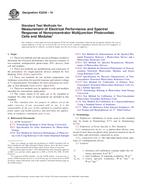Potrebujeme váš súhlas na využitie jednotlivých dát, aby sa vám okrem iného mohli ukazovať informácie týkajúce sa vašich záujmov. Súhlas udelíte kliknutím na tlačidlo „OK“.
ASTM E2236-10
Standard Test Methods for Measurement of Electrical Performance and Spectral Response of Nonconcentrator Multijunction Photovoltaic Cells and Modules
Automaticky preložený názov:
Štandardné skúšobné metódy pre meranie elektrických vlastností a Spektrálna odozva Nonconcentrator Multijunction fotovoltaických článkov a modulov
NORMA vydaná dňa 1.6.2010
Informácie o norme:
Označenie normy: ASTM E2236-10
Poznámka: NEPLATNÁ
Dátum vydania normy: 1.6.2010
Kód tovaru: NS-44754
Počet strán: 5
Približná hmotnosť: 15 g (0.03 libier)
Krajina: Americká technická norma
Kategória: Technické normy ASTM
Anotácia textu normy ASTM E2236-10 :
Keywords:
Solar Energy, Photovoltaics, Multijunction Devices, Electrical Performance, Spectral Response, Nonconcentrator multijunction PV cells/modules, Photovoltaic (PV) power systems, Solar energy, Electrical performance--solar devices, Spectral data--solar devices, Two terminal multijunction PV devices, ICS Number Code 27.160 (Solar energy engineering)
Doplňujúce informácie
| Significance and Use | ||||||||||||||||||||||||
|
In a series-connected multijunction PV device, the incident total and spectral irradiance determines which component cell will generate the smallest photocurrent and thus limit the current through the entire series-connected device. This current-limiting behavior also affects the fill factor of the device. Because of this, special techniques are needed to measure the correct I-V characteristics of multijunction devices under the desired reporting conditions (see Test Methods E1036). These test methods use a numerical parameter called the current balance which is a measure of how well the test conditions replicate the desired reporting conditions. When the current balance deviates from unity by more than 0.03, the uncertainty of the measurement may be increased. The effects of current limiting in individual component cells can cause problems for I-V curve translations to different temperature and irradiance conditions, such as the translations recommended in Test Methods E1036. For example, if a different component cell becomes the limiting cell as the irradiance is varied, a discontinuity in the current versus irradiance characteristic may be observed. For this reason, it is recommended that I-V characteristics of multijunction devices be measured at temperature and irradiance conditions close to the desired reporting conditions. Some multijunction devices have more than two terminals which allow electrical connections to each component cell. In these cases, the special techniques for spectral response measurements are not needed because the component cells can be measured individually. However, these I-V techniques are still needed if the device is intended to be operated as a two-terminal device. Using these test methods, the spectral response is typically measured while the individual component cell under test is illuminated at levels that are less than Eo. Nonlinearity of the spectral response may cause the measured results to differ from the spectral response at the illumination levels of actual use conditions. |
||||||||||||||||||||||||
| 1. Scope | ||||||||||||||||||||||||
|
1.1 These test methods provide special techniques needed to determine the electrical performance and spectral response of two-terminal, multijunction photovoltaic (PV) devices, both cell and modules. 1.2 These test methods are modifications and extensions of the procedures for single-junction devices defined by Test Methods E948, E1021, and E1036. 1.3 These test methods do not include temperature and irradiance corrections for spectral response and current-voltage (I-V) measurements. Procedures for such corrections are available in Test Methods E948, E1021, and E1036. 1.4 These test methods may be applied to cells and modules intended for concentrator applications. 1.5 The values stated in SI units are to be regarded as standard. No other units of measurement are included in this standard. 1.6 This standard does not purport to address all of the safety concerns, if any, associated with its use. It is the responsibility of the user of this standard to establish appropriate safety and health practices and determine the applicability of regulatory limitations prior to use. |
||||||||||||||||||||||||
| 2. Referenced Documents | ||||||||||||||||||||||||
|
Odporúčame:
EviZak - všetky zákony vrátane ich evidencie na jednom mieste
Poskytovanie aktuálnych informácií o legislatívnych predpisoch vyhlásených v Zbierke zákonov od roku 1945.
Aktualizácia 2x v mesiaci !
Chcete vedieť viac informácii ? Pozrite sa na túto stránku.




 Cookies
Cookies
